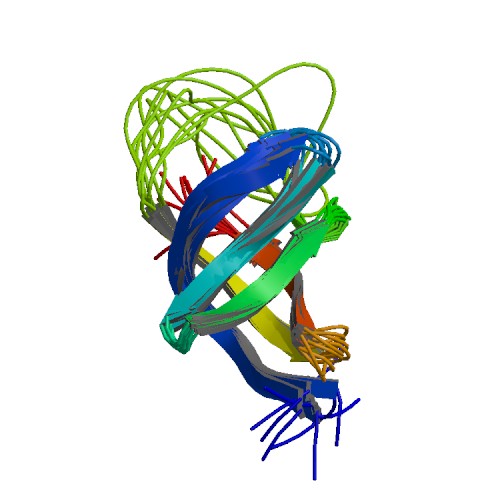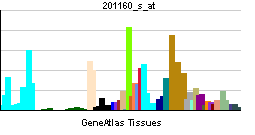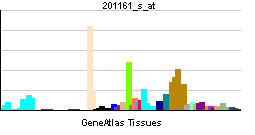CSDA
Jump to navigation
Jump to search
| Cold shock domain protein A | |||||||||||||
|---|---|---|---|---|---|---|---|---|---|---|---|---|---|
 PDB rendering based on 1h95. | |||||||||||||
| |||||||||||||
| Identifiers | |||||||||||||
| Symbols | CSDA ; CSDA1; DBPA; ZONAB | ||||||||||||
| External IDs | Template:OMIM5 Template:MGI HomoloGene: 2708 | ||||||||||||
| |||||||||||||
| RNA expression pattern | |||||||||||||
 | |||||||||||||
 | |||||||||||||
| More reference expression data | |||||||||||||
| Orthologs | |||||||||||||
| Template:GNF Ortholog box | |||||||||||||
| Species | Human | Mouse | |||||||||||
| Entrez | n/a | n/a | |||||||||||
| Ensembl | n/a | n/a | |||||||||||
| UniProt | n/a | n/a | |||||||||||
| RefSeq (mRNA) | n/a | n/a | |||||||||||
| RefSeq (protein) | n/a | n/a | |||||||||||
| Location (UCSC) | n/a | n/a | |||||||||||
| PubMed search | n/a | n/a | |||||||||||
Cold shock domain protein A, also known as CSDA, is a human gene.[1]
References
Further reading
- Lloberas J, Soler C, Celada A (1998). "Repression mechanisms of the I-A beta gene of the major histocompatibility complex". Immunobiology. 198 (1–3): 249–63. PMID 9442396.
- Sakura H, Maekawa T, Imamoto F; et al. (1989). "Two human genes isolated by a novel method encode DNA-binding proteins containing a common region of homology". Gene. 73 (2): 499–507. PMID 2977358.
- Kudo S, Mattei MG, Fukuda M (1995). "Characterization of the gene for dbpA, a family member of the nucleic-acid-binding proteins containing a cold-shock domain". Eur. J. Biochem. 231 (1): 72–82. PMID 7628487.
- Coles LS, Diamond P, Occhiodoro F; et al. (1996). "Cold shock domain proteins repress transcription from the GM-CSF promoter". Nucleic Acids Res. 24 (12): 2311–7. PMID 8710501.
- Funke B, Zuleger B, Benavente R; et al. (1996). "The mouse poly(C)-binding protein exists in multiple isoforms and interacts with several RNA-binding proteins". Nucleic Acids Res. 24 (19): 3821–8. PMID 8871564.
- Weinmann AS, Yan PS, Oberley MJ; et al. (2002). "Isolating human transcription factor targets by coupling chromatin immunoprecipitation and CpG island microarray analysis". Genes Dev. 16 (2): 235–44. doi:10.1101/gad.943102. PMID 11799066.
- Hayashi J, Kajino K, Umeda T; et al. (2003). "Somatic mutation and SNP in the promoter of dbpA and human hepatocarcinogenesis". Int. J. Oncol. 21 (4): 847–50. PMID 12239625.
- Strausberg RL, Feingold EA, Grouse LH; et al. (2003). "Generation and initial analysis of more than 15,000 full-length human and mouse cDNA sequences". Proc. Natl. Acad. Sci. U.S.A. 99 (26): 16899–903. doi:10.1073/pnas.242603899. PMID 12477932.
- Coles LS, Bartley MA, Bert A; et al. (2004). "A multi-protein complex containing cold shock domain (Y-box) and polypyrimidine tract binding proteins forms on the vascular endothelial growth factor mRNA. Potential role in mRNA stabilization". Eur. J. Biochem. 271 (3): 648–60. PMID 14728692.
- Bouwmeester T, Bauch A, Ruffner H; et al. (2004). "A physical and functional map of the human TNF-alpha/NF-kappa B signal transduction pathway". Nat. Cell Biol. 6 (2): 97–105. doi:10.1038/ncb1086. PMID 14743216.
- Beausoleil SA, Jedrychowski M, Schwartz D; et al. (2004). "Large-scale characterization of HeLa cell nuclear phosphoproteins". Proc. Natl. Acad. Sci. U.S.A. 101 (33): 12130–5. doi:10.1073/pnas.0404720101. PMID 15302935.
- Gerhard DS, Wagner L, Feingold EA; et al. (2004). "The status, quality, and expansion of the NIH full-length cDNA project: the Mammalian Gene Collection (MGC)". Genome Res. 14 (10B): 2121–7. doi:10.1101/gr.2596504. PMID 15489334.
- Frankel P, Aronheim A, Kavanagh E; et al. (2005). "RalA interacts with ZONAB in a cell density-dependent manner and regulates its transcriptional activity". EMBO J. 24 (1): 54–62. doi:10.1038/sj.emboj.7600497. PMID 15592429.
- Tao WA, Wollscheid B, O'Brien R; et al. (2005). "Quantitative phosphoproteome analysis using a dendrimer conjugation chemistry and tandem mass spectrometry". Nat. Methods. 2 (8): 591–8. doi:10.1038/nmeth776. PMID 16094384.
- Rual JF, Venkatesan K, Hao T; et al. (2005). "Towards a proteome-scale map of the human protein-protein interaction network". Nature. 437 (7062): 1173–8. doi:10.1038/nature04209. PMID 16189514.
- Sourisseau T, Georgiadis A, Tsapara A; et al. (2006). "Regulation of PCNA and cyclin D1 expression and epithelial morphogenesis by the ZO-1-regulated transcription factor ZONAB/DbpA". Mol. Cell. Biol. 26 (6): 2387–98. doi:10.1128/MCB.26.6.2387-2398.2006. PMID 16508013.
- Olsen JV, Blagoev B, Gnad F; et al. (2006). "Global, in vivo, and site-specific phosphorylation dynamics in signaling networks". Cell. 127 (3): 635–48. doi:10.1016/j.cell.2006.09.026. PMID 17081983.
External links
- CSDA+protein,+human at the US National Library of Medicine Medical Subject Headings (MeSH)
| This protein-related article is a stub. You can help Wikipedia by expanding it. |
This article incorporates text from the United States National Library of Medicine, which is in the public domain.